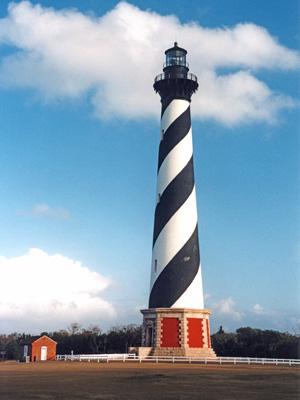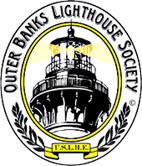CAPE HATTERAS LIGHTHOUSE
Cape Hatteras Lighthouse
Buxton, NC
Latitude: 35.2501
Longitude: -75.5295
In 1796 The United States Congress took up the debate as to whether a lighthouse should be constructed on the Outer Banks of North Carolina. Shippers had been complaining for years about the dangerous shoals located off the coast. But because of fiscal restraints and indecision, nothing was done for six years.
Finally, in 1802, money was appropriated to build a light at Cape Hatteras. The new tower was originally 95 feet above sea level. It was an octagonal tower built of sandstone block sitting on a stone foundation. The builder was Henry Dearborn, a man who had attained a respected reputation as a physician, congressman, Revolutionary war officer and later, Ambassador of Portugal.
The lighthouse, which contained Argand lamps and parabolic reflectors, was considered by most ships' captains to be unsatisfactory. Their complaint was that the light had little or no visibility during haze or low fog. So, in 1851 the Lighthouse Board, after hearing many complaints and recommendations, decided to have the lighthouse raised to 150 feet as well as be fitted with a new first-order Fresnel lens. This work was completed in 1854.

At the end of the Civil War, engineer for the Fifth District, William J. Newman, informed the new Light-House Board that the existing light was in bad shape and beyond repair. Based on Newman's report, it was the board's recommendation that the lighthouse be replaced with something more modern in order to handle the evergrowing shipping needs in this important and dangerous area. In 1867, Congress appropriated the necessary funds and construction was begun in 1868. At $155,000 the second Cape Hatteras Light was one of the more expensive lights on the East Coast and no expense was spared on the design and materials. The present lighthouse contains approximately 1,250,000 bricks, which came from various brick kilns along the James River in Virginia. Dexter Stetson, a shipbuilder from Massachusetts was chosen as the superintendent of construction.
On December 16th, 1870, the light was activated and the new conical shaped brick tower became the tallest lighthouse in the United States, at 198 feet tall, overall. One fact that many are not aware of is that Hatteras' signature spiral-striped daymark was not painted until June of 1873. According to a report filed in July 1871, "The new tower has been covered with a cement wash to protect it from the effects of the weather, the upper part (projected against the sky) colored red, the lower part (projected against the foliage in the rear) colored white."
Because of erosion and the shifting sands of the Outer Banks, the encroaching sea has always been a problem. When built in 1870 the Cape Hatteras Lighthouse was approximately 1,600 feet from the sea. But by 1930 the water was only 150 feet from the base. Over the decades and up through the 1990s, numerous solutions were tried and failed. Finally, upon recommendations from the National Academy of Sciences and the National Park Service, a decision was made to move the historic tower to safety. In 1999, International Chimney Corporation (ICC) began moving the 4,800 ton structure inland 1,600 feet and at an angle away from the coastline some 2,900 feet, putting it in the same relative location from the sea that the original light was located 100 years earlier.
The lighthouse is currently closed due to an extensive historic renovation project. Please visit: https://www.nps.gov/caha/planyourvisit/lighthouseclimbs.htm.
For more information on the restoration visit: https://www.nps.gov/caha/learn/news/cape-hatteras-lighthouse-restoration-project.htm, and for a virtual visitor experience visit: https://www.nps.gov/caha/learn/historyculture/virtual-lighthouse-experiences.htm.
Directions: The lighthouse is located just off Hwy 12 near the village of Buxton, NC. Buxton is located approximately 50 miles south of Nags Head, NC. If you are traveling south on Hwy 12 the turn off is on your left just after you drive through the town. Watch for the signs.
